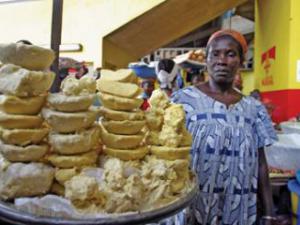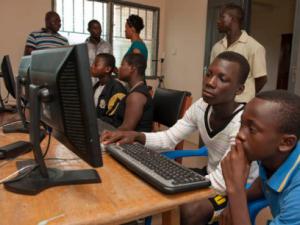GOOD PRACTICE: Use of ICT tools to support informal workers to climb up the value chain and organizing the women producers (Ghana)
Discussion details

In 2015, there were nearly as many cell-phones subscriptions as there were inhabitants on this planet (7. 1 billion against 7.3). Still ICTs have the challenge to improve the lives of the poorest that stayed out. Many of them are at the bottom of agro-processing value chains such as the shea nut and butter value chain. ICT can play a major role in value chain strategies because knowledge of market prices helps inform sellers on the best times to sell their products. Many producers/sellers lack such information which they could easily obtain using cell phones.Uncoordinated and fragmented sales practices, resulting in very limited market power, had been identified as a major determinant of shea women processors’ economic vulnerability in Ghana. One of the actions of an EC funded project was to effectively link-up the women shea producers with their market and strengthen the efficiency of the shea supply chain.

Women groups were facilitated to acquire mobile phones through members’ contributions. The women saw cell phone acquisition as an asset so the groups were ready to invest in acquiring them. The phones were used to receive price alerts on chosen markets to keep women informed of the prices of shea nuts and butter received from the buyers. They could then use this information as a decision-making tool to determine the best time to sell.
All group leaders were trained on price information systems. They obtained knowledge on:
- the benefits of receiving access to price information,
- how to convert local measurement units to kilograms and interpret prices expressed per kilo,
- understand the use and management of the mobile phone and interpreting and decoding alerts.

The phones were also used to receive and send information on supply of produce, i.e date of aggregation of individual collections and pickup. The phones were further used to receive information from the microfinance institutions on meetings, disbursements and instalment due dates for loans.
A social private company (the Shea Star Ltd: SSL) was set up in which the community women have shares (through Star Shea Network, SSN). SSL manages the relations with its buyers and suppliers with the aid of a traceability software called Rural Sourcing Manager (RSM) that SAP (a transnational business solutions company in charge of designing and implementing the traceability system for the shea nut products) developed. SSL receives invoices from importers and exporters of butter and nuts ahead of the production season for the quantities of each product and tracks the volumes and values of products from each shea processor within the Shea Star Network. Prices for butter are negotiated between SSL and the buyers while the price for regular nuts are determined based on the spot prices on the market. The five producers associations introduced the use of the RSM to ensure product traceability and production control and management: specifically the warehouse management, the butter production quantities, the pre-payments for the purchase of additional nuts for butter production have been successful through the use of RSM.
Initially, alerts used to be sent to every group weekly but this was changed to one alert per community (of several groups) biweekly. This was because all groups in a community depended on the same literate secretary to translate the information to them. This change also took the price for subscribing to alerts into consideration as it could reveal too expensive to send weekly alerts after the completion of the project.
The market price information service was provided via SMS by Esoko—the on-line provider that provides shea price information. Though it has contributed to drastically reduce the activities of middlemen in the value chains, the method initially appeared unsustainable from the beneficiaries’ point of view. The main reason was the pre-requisite of literacy to profit from the system. Most women are illiterate and thus find it difficult to read messages. Most of the women explained that they had to rely on their children who are often not available (in school) at the time when they are needed. The project adjusted the approach to function via the shea producers groups literate secretary.

The sustainability of the subscription to Esoko was also threatened by the fact that many communities lack electricity to charge their phones and good communication network services. Esoko is constrained because, unlike SSL which provides both local and foreign market information, Esoko shares only local market prices with women. Nevertheless, the mobile phones have equipped the women to source for competitive market prices for their produce to guide their choices regarding production plans.
Market information flow among the key actors of the shea value chain was found to be quick and informative. However, the available evidence indicates that market information flows top-down. This means that in most cases market information is generated at the top (Star Shea Ltd) and then downwards to the women shea processing groups through the Star Shea Network at the regional level and the Associations at the district level. The top-down approach in communication is found to be less effective and therefore does not sufficiently help functioning of the shea value chain due to information delays and, sometimes, information gaps. It would have been useful to have also shea business information or issues generated at the group level and sent upwards through the established structures to SSL.
Compared with other sources of information, the shea producer women said they value price information such as that provided through the value chain actor, that is, SSL. The explanation is that the price information supplied by SSL has really opened their eyes to see the value addition along the chain. The new way of receiving price information has also built the women’s bargaining power to determine whether market prices offered are good or not. The women have learnt how to source for information regarding prices of shea products by using phone calls and text messaging. This enables them compare prices and choose the best ones. However the beneficiaries appeared to prefer the in-person market information exchange (e.g. through SSL) as compared to electronic messages.
__________________________________________________________________________________________
Identification of Innovative Approaches to Livelihood Enhancement, Equity and Inclusion of People Dependent on the Informal Economy
Volume 1: Good Practices and Lessons Learned
Extracted from 33 Projects Selected Under the 2009 EC call for Proposals:
“Investing in People. Promoting social cohesion, employment and decent work. Support for social inclusion and social protection of workers in the informal economy and of vulnerable groups at community level”
March 2016
By Jacques Charmes, Mei Zegers
Log in with your EU Login account to post or comment on the platform.